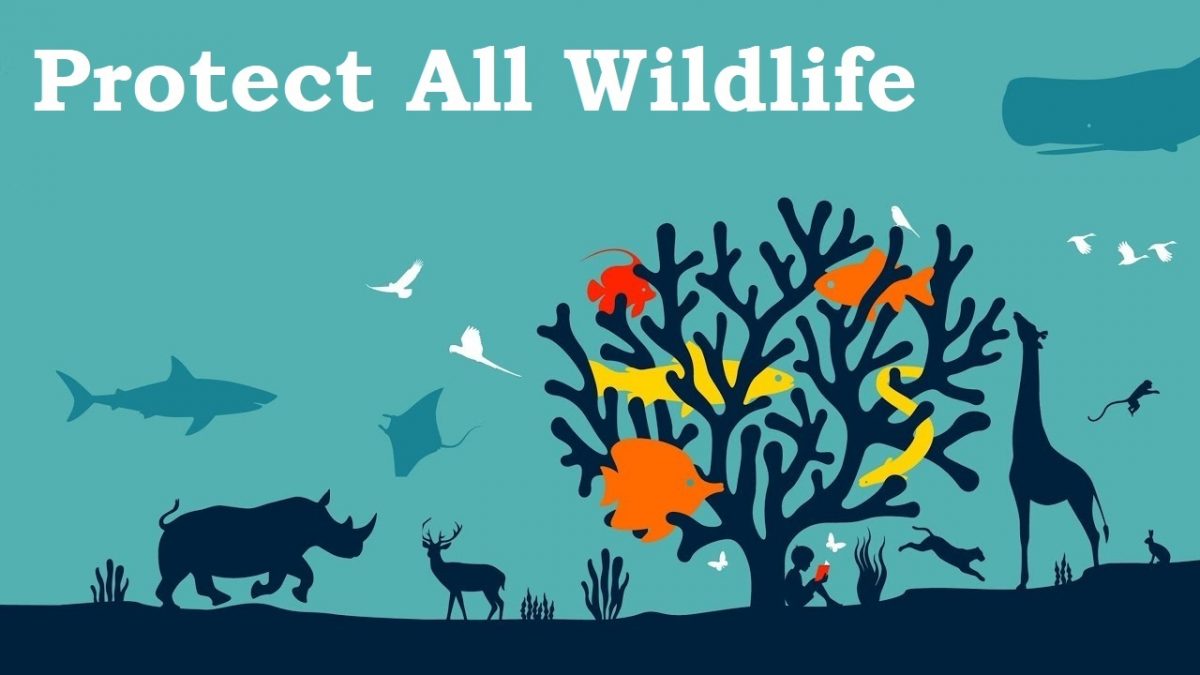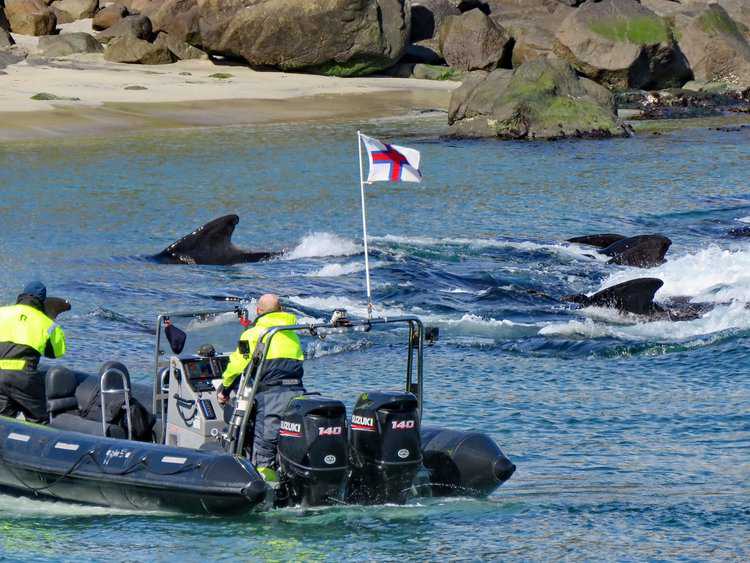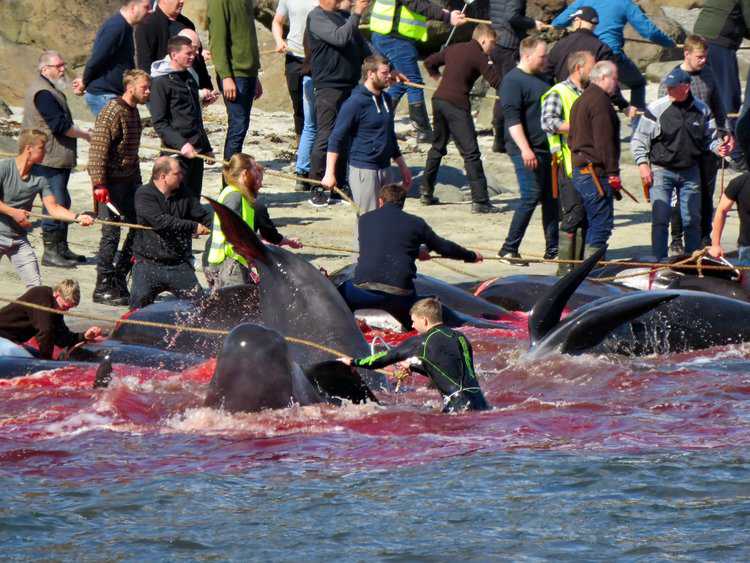A new season started on September 1. Entire families of dolphins will be devastated for aquariums to draw crowds.

Just after 6am, a fleet of 11 fishing boats left Taiji harbour on Japan’s southern Pacific coast. Within an hour, the boats were lined up in a formation, encircling a pod of 18 Risso’s dolphins and forcing them into a cove. Nets were set to trap the dolphins, and soon after, seven dolphin trainers from the Taiji Whale Museum arrived.
One by one, the divers caught the dolphins and took them under grey tarps that were meant to shield their work from the scrutiny of outside observers. Under the tarps, the dolphin trainers examined the sex and size of the dolphins, estimated their age and selected two for sale to aquariums — appearance and suitability for training are usually key factors. They were placed on stretchers and taken to sea pens set in a nearby bay.
Just an hour earlier, these dolphins had been swimming freely in the ocean with their family. Now, they were facing a life in a small concrete pool, performing tricks to entertain people who rarely think about how the dolphins ended up there.
The fate of the 16 unchosen dolphins was even more cruel. Hunters struck them with a sharp metal spike into their necks just behind the blowholes, making them suffocate in their own blood, turning the ocean water around them red. Their dead bodies were dragged into Taiji fishing port, soon to become meat products.
In a matter of a few hours, an entire family of dolphins was destroyed as part of what some local fishermen and Japanese politicians call a “tradition”.
Inconvenient truth
On September 1, a new season of cruelty will begin. The small town of Taiji made global headlines after the 2010 Academy Award-winning documentary film, The Cove, highlighted Japan’s little-known dolphin hunting practice. While the film was highly acclaimed worldwide, it received a backlash in Japan as conservatives called it an attack on the country’s culture.
More than a decade has passed and the world has changed. Climate change is considered humanity’s biggest challenge. Governments and corporations around the world are working towards sustainability goals, including wildlife conservation. Sadly, in Japan, dolphin hunts continue as they did earlier, while the world’s attention has faded away.
During the six-month hunting season each year, I’m confronted with a truth that’s inconvenient for many people considering the enormous popularity of dolphins at aquariums. Dolphins form strong family bonds, moving together to protect the young and old who cannot swim fast enough when chased by hunters. Dolphins are also generally gentle and do not attack humans even to defend themselves. This makes it easy for hunters to catch entire pods.
Our investigation revealed that at least 563 dolphins were taken from the wild in Taiji alone during the 2021-22 season, of which 498 were slaughtered and 65 were kept for aquariums. The dolphin hunts are conducted across Japan, often using spearfishing. Taiji is particularly notorious because hunters here usually catch entire pods, leaving no chance for families to recover and causing a devastating impact on the dolphin population.

Already, the number of dolphins that hunters are trapping is declining — it has dropped almost to a quarter of the 2,077 dolphins caught in 2000 — even though they go out to the ocean searching for their prey every day during the season. Today, hunters are unable to meet the annual government-set catch quota of 1,849 dolphins.

A wild animal exporting industry
It’s a little-known fact that hunting really started only in 1969 with the establishment of the Taiji Whale Museum in order to display live dolphins. This was around the time when the United States was booming with dolphinariums driven by a popular TV series Flipper, in which a dolphin was a lead character.
A live dolphin is sold for as much as JPY 5 million ($36,000) overseas, while it only fetches JPY 50,000 ($360) as meat.
The Japanese government has defended the hunt as part of local culinary tradition, but hardly anyone in the country eats dolphin meat. In reality, this is about the trade of dolphins to aquariums for entertainment across the world, hiding behind “tradition”. In essence, it’s an animal export industry.
In fact, our research revealed that as of March 11, 2022, 269 dolphins and small whales were being kept as inventory in a massive set of sea pens in Taiji’s Moriura Bay, waiting to be sold to aquariums across Japan and the world. The hunt only continues because of the demand for human entertainment.
Change is coming
There is reason for hope, though. In March of this year, Sweden’s Kolmården zoo, the largest zoo in Scandinavia, announced it will end its dolphin shows. The decision by the zoo, which holds 12 captive dolphins, is symbolic of a new attitude towards animals around the world. Last November, the French parliament passed a bill that bans dolphin shows as well as wild animals used in circuses. A similar ban has been in place in Canada since 2019.
Coastal countries, such as India, Chile, Costa Rica and Brazil, also ban or restrict the captivity of dolphins. Expedia is the latest among travel agencies to stop selling tickets that include dolphin shows.
In Japan, too, there are signs that attitudes are beginning to shift. In May, a Tokyo-based aquarium became the first such facility in the country to end its dolphin show. It claimed financial burden as the primary reason, but it also mentioned the global trend in recent years. And the following month, another aquarium announced that it will discontinue sea lion shows.
Change is coming, slowly but surely. Until then, I will continue my work in Taiji to tell the people of Japan what we are doing to the animal we claim to love.
This article by Ren Yabuki was first published by Aljazeera on 31 August 2022.

What you can do to help wildlife:
We believe EVERY animal should be treated with respect, empathy, and understanding. We raise awareness to protect and conserve wild, captive, companion and farm animals. It is vital that we protect animals against acts of cruelty, abuse, and neglect by enforcing established animal welfare laws and, when necessary, take action to ensure that those who abuse animals are brought to justice.
Protect All Wildlife are involved in many projects to protect animals’ rights, welfare, and habitats. Money contributed to Protect All Wildlife supports ALL of our worthy programmes and gives us the flexibility to respond to emerging needs. Your donations make our work possible. Thank you for your support.
Everyone who donates will receive a Certificate of Appreciation as a thank you for supporting wildlife.








